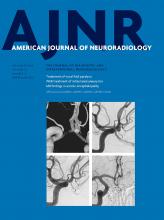Table of Contents
Perspectives
Review Article
Methodologic Perspectives
General Contents
- Association of Automatically Quantified Total Blood Volume after Aneurysmal Subarachnoid Hemorrhage with Delayed Cerebral Ischemia
The authors retrospectively studied clinical and radiologic data of 333 consecutive patients with aneurysmal SAH between January 2009 and December 2011. Adjusted odds ratios werecalculated for the association between automatically quantified total blood volume on NCCT and delayed cerebral ischemia (clinical, radiologic, and both). The adjusted OR of total blood volume for delayed cerebral ischemia was 1.02 per milliliter of blood. They conclude that a higher total blood volume measured with the automated quantification method is significantly associated with delayed cerebral ischemia.
- Centripetal Propagation of Vasoconstriction at the Time of Headache Resolution in Patients with Reversible Cerebral Vasoconstriction Syndrome
In this retrospective cohort study, the authors evaluated 16 patients diagnosed with reversible cerebral vasoconstriction syndrome who underwent MR imaging, including MRA, within 72 hours of RCVS onset (initial MRA) and within 48 hours of thunderclap headache remission. In 14 of the 16 patients (87.5%), centripetal propagation of vasoconstriction occurred from the initial MRA to remission of thunderclap headache, with typical segmental vasoconstriction of major vessels (M1, P1, A1). The authors conclude that there is evidence of centripetal propagation of vasoconstriction on MRA performed at the time of remission of the thunderclap headache, and this time point may represent a useful opportunity to diagnose RCVS with greater confidence.
- Quantitative Susceptibility Mapping and R2* Measured Changes during White Matter Lesion Development in Multiple Sclerosis: Myelin Breakdown, Myelin Debris Degradation and Removal, and Iron Accumulation
The authors characterized lesion changes on quantitative susceptibility mapping and R2* at various gadoliniumenhancementstages (nodular, shell-like, nonenhancing) in 64 patients with 203 lesions. They found that: 1) active MS lesions with nodular enhancement show R2* decrease but no quantitative susceptibility mapping change; 2) late active lesions with peripheral enhancement show R2* decrease and quantitative susceptibility mappingincrease in the lesion center; and 3) nonenhancing lesions show both quantitative susceptibility mapping and R2* increase, reflecting iron accumulation.
- Risk Factors for Ischemic Complications following Pipeline Embolization Device Treatment of Intracranial Aneurysms: Results from the IntrePED Study
This is a retrospective subanalysis of the IntrePED study, which has beenpreviously published (AJNR Am J Neuroradiol 2015;36:108–15).Seven hundred ninety-three patients with 906 treated aneurysms were enrolled. Thirty-six (4.5%) patients had postoperative acute ischemic stroke, 21 of which occurred within 1 week of the procedure. There was no difference in the rate of acute stroke between the anterior and posterior circulations. Stroke rate was 3% in patients with 1 PED, and 7% in those with 2 PEDs. With multivariate analysis, the only variable independently associated with postoperative stroke was treatment of fusiform aneurysms. Among the patients with stroke, 10 (27.0%) died and 26 (73.0%) had major neurologic morbidity. The authors conclude that acute ischemic stroke following treatment of intracranial aneurysms with the PED is an uncommon but devastating complication, with 100% of patients having major morbidity or mortality.
- WEB Treatment of Ruptured Intracranial Aneurysms
This observational cohort study evaluated 32 patients with 32 acutely ruptured aneurysms endovascularly treated with the Woven EndoBridge (WEB) device. The mean aneurysm size was 4.9 mm, with 14 less than or equal to 4 mm, and most had a wide neck. All aneurysms were adequately occluded, and there were no procedural ruptures or complications related to the WEB device. No adjunctive stents or balloons were needed. Seven patients with poor clinical grade died during hospital admission due to the sequelae of their subarachnoid hemorrhage. The authors conclude that WEB treatment of small ruptured aneurysms was safe and effective without the need for anticoagulation, adjunctive stents, or balloons.
- Correlation of MRI Brain Injury Findings with Neonatal Clinical Factors in Infants with Congenital Diaphragmatic Hernia
The authors evaluated MRIs performed before hospital discharge in 53 infants with congenital diaphragmatic hernia that were scored forbrain injury by 2 pediatric neuroradiologists. Potential associations with perinatal and clinical variables from the neonatal intensive care unit stay were probed. The most common findings were enlarged extra-axial spaces (36%), intraventricular hemorrhage (23%), ventriculomegaly (19%), white matter injury (17%), and cerebellar hemorrhage (17%). Brain injury score was associated with extracorporeal membrane oxygenation, lack of oral feeding at discharge, use of inotropes, and gastrostomy tube placement before hospital discharge.



